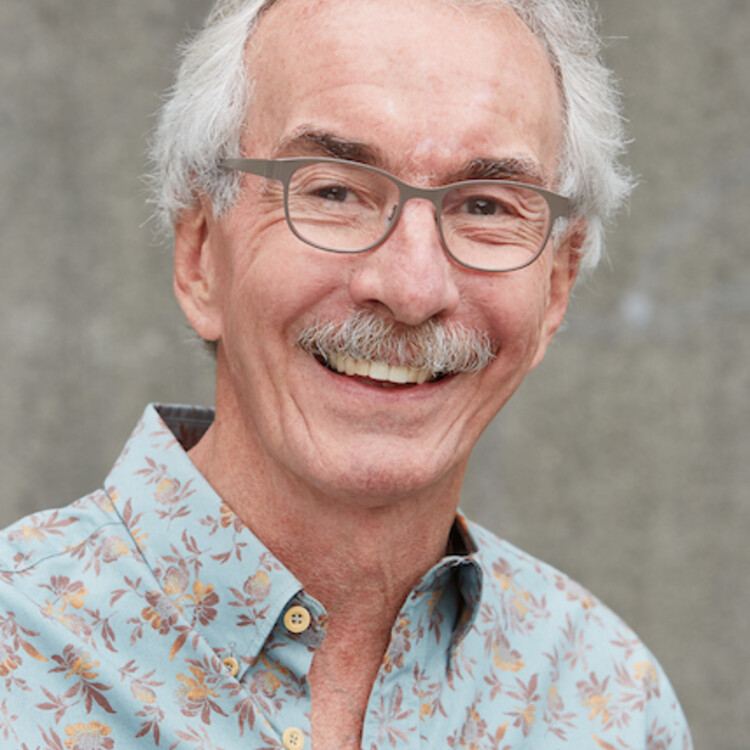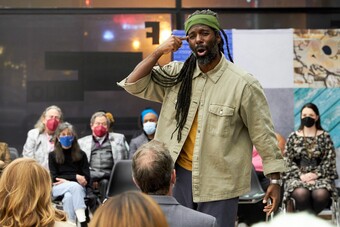It would be impossible to talk about my experience in Cimientos, IATI Theater’s play development program, without the context of the script I had submitted that was shared and discussed by participants. The Space Between is essentially a long free verse poem, written to be performed. The piece offers considerable creative freedom to the director. An excerpt of the stage directions reads:
“This play is written to be performed by a diverse ensemble. The director may determine the size and make up of the cast, and who speaks which lines.
The time is the present—if you believe in that sort of thing. The location is anywhere. Some slight improvisation with the text is permitted, even encouraged.”
I consider myself an “emerging artist” at age seventy-three, a term usually reserved for those just out of grad school. But, that said, I returned to work in theatre around six years ago after a forty-year hiatus. I face the same gatekeepers, challenges, and obstacles as my younger colleagues, with the added challenge of ageism (“if you were any good, why haven’t we heard of you?”). The theatre community has yet to grasp that “young” and “new” are not synonymous terms, nor are “young” and “relevant.” That’s part of what made being selected as a participant in the IATI workshop so special: it created a space for the public validation of one’s work.
Cimientos was structured as a series of weekly Zoom calls, spaced out over three months. Each week we received a script from one of the playwrights that served as the discussion topic for the next call. Playwrights wrote both in English and Spanish, so translations of the scripts were provided. Interpreters were on the Zoom calls to provide instant translations of comments and questions. IATI staff facilitated the conversations with minimal structure.
From the outset, one of the biggest eye-openers in the discussion of the works was the importance of cultural context in the plays. Playwrights were from Argentina, Chile, Germany, Kenya, Mexico, and the United States. In addition, we gradually came to understand that members of our cohort were often writing from the perspectives of specific subcultures or groups within our countries, informed by gender identity, race, age, economic position, political affiliation, ethnicity, or some combination of these factors.
The Cimientos cohort became a community of shared experience. Just the fact that there were these people out there doing the work, day by day, and the wide range of stories being brought to life, was a source of inspiration and confidence.
The subtleties of some of these unconscious perspectives were not always apparent to those outside a linguistic and/or cultural group. In Walter Sitati’s play Stars with Exit Wounds, set in Kenya, the daughter of an impoverished family, is said to be “away at boarding school.” To the American and European readers, boarding schools were thought of as a privilege of the rich. In Kenya, however, they are run by missionaries and more normalized. Nicolás Bascuñan's allegorical play Ñachi, revolves entirely around the struggle between Chile’s indigenous Mapuche people and the Chilean government/dominant culture. Chileans would immediately recognize this, but to readers without knowledge of that history, that aspect of the work is somewhat opaque and so diminished.
Naturally, all the writers, wrote from our own cultural perspectives, and the work was enriched by the level of authentic detail and our immersion in our own worlds, be they gaming culture, online dating, Native American worldview, Judeo-Christian mythology, etc. How these perspectives informed the development of themes, plot, and characters in the plays was a common thread among the weekly discussions. Playwrights were, of course, not writing for an international audience but for their own people. The workshop cohort was international and multicultural. This proved to be both a strength and a liability.
I tend to work pretty much in isolation, and the last couple COVID years have ratified that habit. The opportunity to have an extended conversation with this diverse group of writers—to hear their stories, their challenges, and the ways they brought their ideas to the page—was an education in itself. A simple question of, “Why did you end that scene this way?” would elicit a ten-minute explanation revealing the understructure and strategy of writing choices that paid off pages later.
Being able to dig into the other playwrights’ processes as they created the worlds of their plays—and the ways that the unconscious and deliberate biases of their particular cultural positions helped shape those worlds—was one of the greatest benefits on the Cimientos experience. In my case, I think it is fair to say that the Cimientos workshop probably had more influence on the play I was writing over the course of the workshop (Small Ordinary Gods) than the play I had submitted (The Space Between) that was read and discussed by the group.
The Cimientos cohort became a community of shared experience. Just the fact that there were these people out there doing the work, day by day, and the wide range of stories being brought to life, was a source of inspiration and confidence. Looking back, I believe that I made more risky choices writing Small Ordinary Gods, a result of watching my colleagues trust—and act on—their instincts.
Responses from the group to The Space Between were generally favorable but mixed. Over the course of the weekly discussions, we got to know one another. It became evident that there were some participants who were more at home with a more formal traditional narrative structure and those whose who embraced more experimental dramatic forms. This was not necessarily a source of conflict, or even disagreement but was expressed in the ways that the plays were addressed in the discussions and questions.
The plays with a chronological narrative arc seemed more accessible to a larger segment of the group—in other words, they were simply easier to read on the page. Those that pushed the dramatic form and were only to be fully realized in production, were a harder read, and as a result were less-served by the read-and-discuss methodology. It would have been interesting to have included some stage directors among the discussion participants, bringing their experience in bringing the text on the page to life onstage.
It is always enlightening to hear what others see in one’s work. In my case, I was surprised to hear that what I intended to be subtle internal references—ideas from one section, picked up again and voiced in another—were noted as redundant or even mistakes! I did make a number of edits as a result of this feedback, however. Similarly, there was some small consensus that the play was too long —sixty pages in verse clocks in at just about an hour, so it is maybe ninety minutes in performance, which is hardly a long play. Looking back, I expect that, again, the fact that the work was read rather than heard elicited this response.
Some found the form—a range of “verses” from as few as fifty words to more than a thousand in length—to be rewarding. One playwright noted, “I loved how it kept surprising me, just when I thought I figured it out, you pulled the rug out from under me… and then again and again.” Others struggled, their expectation of a finding a narrative plot preventing them from experiencing what was actually there.
The Cimientos workshop concluded with live readings of the works at IATI. It was an eye-opener for me to see what my silent partner, director Katrin Hilbe, did with the text, and experience the work brought to life. This is a critical and magical moment of letting go of the writing and passing it on. ******













Comments
The article is just the start of the conversation—we want to know what you think about this subject, too! HowlRound is a space for knowledge-sharing, and we welcome spirited, thoughtful, and on-topic dialogue. Find our full comments policy here